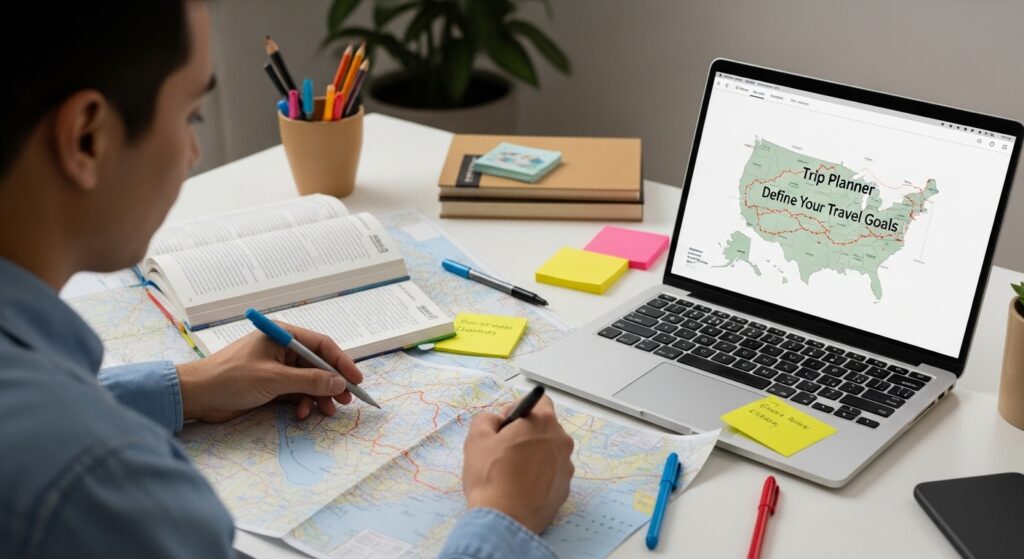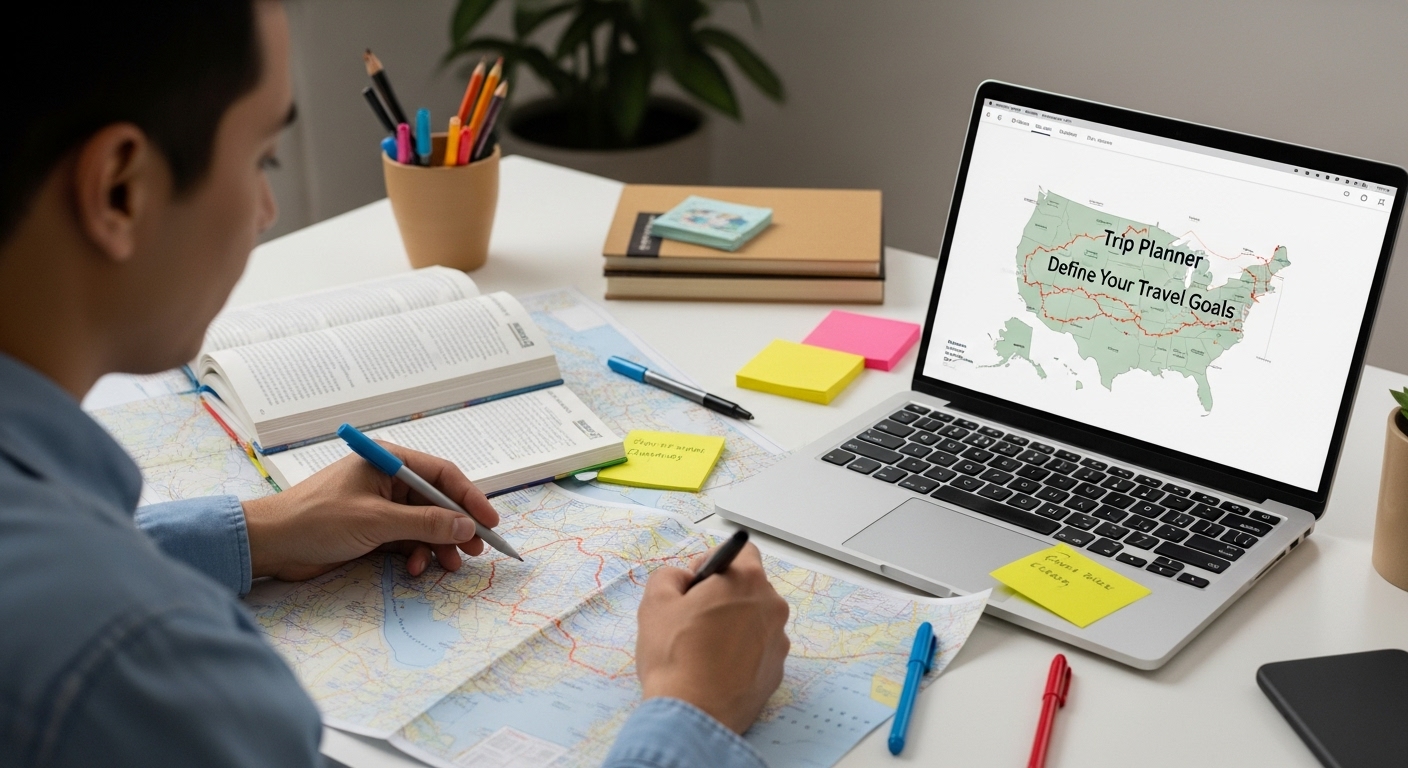Planning a trip across the United States sounds exciting, but turning those dreams into a real-life adventure can feel overwhelming fast. Most people jump straight to booking flights or picking hotel rooms, skipping the steps that actually shape the trip. Yet, research shows that travelers who map out their goals and preferences first enjoy up to 40 percent more satisfaction with their journeys. Start your adventure smarter, not harder, and discover how a few simple decisions can change your entire American experience.
Table of Contents
- Step 1: Define Your Travel Goals And Preferences
- Step 2: Research Destinations And Activities
- Step 3: Create A Detailed Itinerary
- Step 4: Budget Your Trip Wisely
- Step 5: Book Accommodations And Transportation
- Step 6: Review And Finalize Your Travel Plans
Quick Summary
| Key Point | Explanation |
|---|---|
| 1. Define clear travel goals | Understand your motivations and preferences to tailor your trip uniquely to you. |
| 2. Thoroughly research destinations | Collect detailed information on locations that align with your travel objectives to optimize your experience. |
| 3. Create a flexible itinerary | Develop a structured plan that allows for spontaneity while scheduling your trip activities effectively. |
| 4. Budget realistically for expenses | Break down and prioritize costs to ensure a financially viable adventure without compromising experiences. |
| 5. Confirm and organize all bookings | Review all travel arrangements for accuracy and keep essential documents in a centralized location for easy access. |
Step 1: Define Your Travel Goals and Preferences
Your American adventure begins with a critical first step: clearly defining your travel goals and preferences. This foundational stage transforms a generic trip into a personalized journey that reflects your unique interests and desires. Understanding what you truly want from your travel experience will guide every subsequent planning decision.
Start by conducting an honest self-assessment of your travel motivations. Are you seeking relaxation, adventure, cultural immersion, or a blend of experiences? Consider your personal travel style and energy levels. Some travelers prefer meticulously planned itineraries, while others enjoy spontaneous exploration. Recognize that your travel preferences will directly shape the type of trip you create.
Explore our guide on interest-based trip planning to help you drill down into specific travel objectives. Think about the experiences that genuinely excite you. Do you want to hike national parks, explore vibrant cities, discover historical landmarks, or unwind on scenic beaches? Your goals might include specific activities like photography, culinary exploration, outdoor adventures, or cultural encounters.
Next, assess practical considerations that will influence your trip planning. Evaluate your available time, budget constraints, travel companions, and physical capabilities. A solo backpacking trip across national parks requires different planning compared to a family vacation or a romantic getaway. Consider factors like seasonal variations, personal comfort levels with different travel styles, and any physical or logistical limitations.
Compile a prioritized list of must-have experiences and potential destinations that align with your goals. This list will serve as your trip planning compass, helping you make informed decisions about routes, activities, and accommodations. Remember that flexibility is key—your initial vision might evolve as you research and discover new possibilities throughout the planning process.
By the end of this step, you should have a clear, personalized vision of your ideal American adventure.
 Your defined goals will transform trip planning from a potentially overwhelming task into an exciting journey of anticipation and discovery.
Your defined goals will transform trip planning from a potentially overwhelming task into an exciting journey of anticipation and discovery.
Step 2: Research Destinations and Activities
Researching destinations and activities transforms your travel vision from abstract concept to tangible plan. This critical step involves deep exploration of potential locations, understanding their unique offerings, and matching them precisely with your previously defined travel goals. Your research will determine the roadmap of your American adventure.
Begin by creating a comprehensive list of destinations that align with your initial travel objectives. For national park enthusiasts, investigate regions like the Rocky Mountains, Grand Canyon, or Yellowstone. City lovers might focus on vibrant metropolises such as New York, San Francisco, or Chicago. Check out our comprehensive guide on trip planning to help streamline your research process.
Utilize multiple research channels to gather information. Official tourism websites, travel blogs, social media platforms, and dedicated travel forums offer rich insights into destination characteristics. Pay attention to seasonal variations, local events, accessibility, and unique experiences specific to each location. Look beyond surface-level attractions and seek out authentic experiences that resonate with your personal travel style.
Evaluate potential destinations through a practical lens. Consider factors like travel distance, transportation options, accommodation availability, and budget requirements. Create a comparative analysis that weighs the pros and cons of each potential location. Some regions might offer more budget-friendly options, while others provide once-in-a-lifetime experiences that justify higher expenses.
As you research, remain flexible and open to unexpected discoveries. Sometimes the most memorable travel experiences emerge from destinations you hadn’t initially considered. Take detailed notes, bookmark interesting resources, and start building a preliminary understanding of each potential location’s unique character.
By the conclusion of this research phase, you should have a curated list of destinations that not only match your original travel goals but also spark genuine excitement. Your thorough investigation will lay the groundwork for crafting a truly personalized American adventure that reflects your individual interests and aspirations.
Step 3: Create a Detailed Itinerary
Creating a detailed itinerary transforms your travel research into a concrete roadmap for your American adventure. This crucial step requires strategic planning, thoughtful organization, and a balance between structure and flexibility. Your itinerary will serve as the blueprint for your entire travel experience.
Begin by establishing a chronological framework that captures each day of your trip. Start with your arrival and departure dates, then progressively fill in activities, travel times, and potential rest periods. Explore our comprehensive guide on creating travel itineraries to help you develop a systematic approach to planning.
Prioritize realistic scheduling that accounts for travel times, activity durations, and potential unexpected delays. Consider the geographical proximity of attractions and plan routes that minimize unnecessary backtracking. For instance, if you are exploring a national park, group nearby hiking trails or scenic locations together to optimize your travel efficiency. Factor in adequate transition times between activities to prevent exhaustion and allow for spontaneous discoveries.
Utilize digital and physical tools to track and organize your itinerary details. Digital platforms offer interactive maps, real-time updates, and collaborative planning features. Create a centralized document or use a dedicated travel planning app that allows you to store confirmation numbers, booking details, and important contact information. Include critical details like accommodation addresses, transportation schedules, and emergency contact numbers.
Remember that a great itinerary maintains a delicate balance between structured planning and adaptable exploration. Build some flexibility into your schedule by including buffer times and alternative activity options. This approach allows you to accommodate unexpected opportunities or rest when needed without feeling constrained by a rigid plan.
By the end of this step, you should have a comprehensive, personalized itinerary that reflects your travel goals, maximizes your destination experiences, and provides a clear roadmap for your American adventure. Your meticulously crafted plan will transform potential travel stress into excited anticipation of the memorable journey ahead.
Step 4: Budget Your Trip Wisely
Budgeting transforms your travel dreams from wishful thinking into achievable reality. This critical step requires strategic financial planning, meticulous tracking, and smart decision making that balances your travel aspirations with fiscal responsibility. Your budget will determine the scope and quality of your American adventure.
Discover our top tips for saving money on travel to maximize your trip’s potential while minimizing unnecessary expenses. Start by establishing a comprehensive financial blueprint that accounts for all potential travel costs. Break down your budget into key categories: transportation, accommodation, food, activities, emergency funds, and miscellaneous expenses. Consider using spreadsheet tools or dedicated travel budgeting apps to track and categorize your anticipated spending.
Calculate your total trip budget by researching realistic cost estimates for each destination. Factor in seasonal variations, local pricing differences, and potential additional expenses like park entry fees, rental car costs, or unexpected travel needs. Be conservative in your estimations and always include a financial buffer of 10 to 15 percent to cover unexpected circumstances or spontaneous opportunities.
Explore cost-saving strategies that can stretch your travel budget without compromising experience quality. Consider traveling during shoulder seasons, which offer lower prices and fewer crowds. Look for bundle deals on accommodations and transportation, utilize travel rewards credit cards, and investigate free or low-cost activities at your destinations. Some national parks offer free entry days, and many cities have complimentary walking tours or museum days that can significantly reduce your expenses.
Prioritize your spending by distinguishing between essential expenses and discretionary spending. Allocate more of your budget to experiences that align with your core travel goals while finding creative ways to minimize costs in less critical areas. This might mean choosing budget-friendly accommodations to splurge on a once-in-a-lifetime activity or selecting affordable dining options to preserve funds for unique experiences.
By the conclusion of this budgeting phase, you should have a clear, realistic financial plan that empowers you to enjoy your American adventure without financial stress. Your carefully crafted budget will serve as a powerful tool, transforming financial constraints into opportunities for creative and memorable travel experiences.
Step 5: Book Accommodations and Transportation
Booking accommodations and transportation represents the pivotal moment where your travel plan transitions from concept to concrete reality. This step requires strategic decision making that balances comfort, convenience, and cost-effectiveness. Your selections will significantly impact the overall quality and smoothness of your American adventure.
Learn how to create a hassle-free trip plan and apply those insights to your accommodation and transportation choices. Begin by cross-referencing your detailed itinerary with potential lodging and travel options. Consider proximity to planned activities, transportation accessibility, and cancellation policies. Look beyond basic pricing and evaluate the total value each option provides. Some accommodations might seem more expensive initially but offer significant savings through included amenities like complimentary breakfast, airport shuttles, or free parking.
For transportation, explore multiple options that align with your itinerary and travel style. Rental cars offer maximum flexibility for road trips, especially when exploring national parks or rural destinations. However, in major cities, a combination of public transportation and ridesharing might prove more economical and stress-free. Compare costs between different transportation modes, factoring in not just ticket prices but also convenience, travel time, and potential additional expenses like parking or baggage fees.
Pay close attention to booking timing and flexibility. Many accommodations and transportation services offer better rates for advance bookings, particularly during peak travel seasons. Look for options with free cancellation or modification policies, which provide financial protection if your plans change. Consider travel insurance that covers transportation and accommodation expenses in case of unexpected disruptions.
Carefully review all booking details before confirming. Double-check dates, times, passenger names, and any special requirements or requests. Save digital and physical copies of all confirmations, including reservation numbers, contact information, and any specific instructions for check-in or boarding. Create a centralized digital folder or travel document that consolidates all your booking information for easy access during your trip.
By the conclusion of this step, you should have a comprehensive set of confirmed accommodations and transportation arrangements that seamlessly support your meticulously planned itinerary. Your strategic bookings will provide the reliable foundation for a smooth, enjoyable American adventure.

Step 6: Review and Finalize Your Travel Plans
Reviewing and finalizing your travel plans represents the critical checkpoint that transforms your meticulously crafted itinerary into a fully realized adventure. This step is about confirming every detail and ensuring your trip is set for smooth execution. Think of it as your travel preparation’s final quality control moment.
Explore our comprehensive guide to trip planning to help you navigate this crucial stage with confidence. Begin by conducting a comprehensive review of all your existing documentation. Verify that all reservation confirmations match your itinerary precisely, checking dates, times, and personal details. Scrutinize your travel documents, ensuring passports are valid, any required visas are secured, and you have appropriate identification for domestic travel.
Create a centralized digital and physical travel folder containing all essential documents. Include copies of reservations, identification, insurance information, emergency contact details, and medical documentation. Consider uploading digital copies to a secure cloud storage service as a backup. Prepare physical copies to carry separately from your original documents, providing an additional layer of security in case of loss.
Contact your mobile service provider to discuss international or roaming coverage if applicable. Investigate potential cellular plans or portable WiFi options that will keep you connected during your journey. Notify your bank and credit card companies about your travel dates and destinations to prevent potential card freezes due to suspicious activity. This proactive communication helps ensure uninterrupted access to your financial resources.
Perform a final budget reconciliation, comparing your initial budget estimates with current booking costs. Identify any potential financial discrepancies and adjust your spending plan accordingly. Consider setting up a dedicated travel notification on your banking apps to track expenses in real time and maintain financial awareness during your trip.
By the conclusion of this step, you should feel a sense of excitement and preparedness.
Here is a checklist to help you review and finalize your travel plans, ensuring that every critical detail is confirmed before your American adventure begins.
| Review Item | Verification Step | Notes/Importance |
|---|---|---|
| Reservation Confirmations | Match all bookings to itinerary dates and details | Avoids scheduling errors and double bookings |
| Travel Documents | Check passport validity and visa requirements | Prevents travel delays or entry refusals |
| Centralized Folder | Compile digital/physical copies of documents | Allows quick access and provides backup |
| Financial Preparations | Notify banks; reconcile budget with bookings | Ensures uninterrupted transactions and clear costs |
| Emergency Contacts & Insurance | Gather contacts and insurance details | Supports emergency readiness and peace of mind |
| Mobile Connectivity | Arrange coverage or international/roaming plans | Maintains communication and mobile access |
| Final Budget Check | Adjust spending plan to reflect actual bookings | Avoids overspending and supports financial control |
Make Your Dream American Trip Effortless with Yopki
Planning a perfect American adventure can quickly become overwhelming. As you saw in the article, juggling detailed itineraries, endless research, budget constraints, and last-minute changes makes travel planning feel more stressful than exciting. You want a journey tailored to your goals, but spreadsheets, scattered bookings, and confusing logistics keep getting in the way of that dream.
Yopki was built to solve exactly these problems. Our all-in-one travel app instantly generates personalized itineraries based on your interests. You get a smart visual map to organize your days and cut down on wasted time. Everything from your flights to activity confirmations stays neatly stored in one hub. No more redoing plans or hunting for travel documents. Our drag-and-drop calendar lets you fine-tune your schedule after every research step, just like the article recommends. Whenever uncertainty strikes, your AI Travel Concierge is ready with answers and support.
See how Yopki can replace the stress of trip planning

Turn your step-by-step adventure into a truly memorable experience. Visit Yopki now to start planning your ideal American trip. Sign up today and let your travel journey begin without the hassle.
Frequently Asked Questions
How do I define my travel goals for a trip?
Start by conducting a self-assessment of your travel motivations. Consider what experiences excite you, such as relaxation, adventure, or cultural immersion, and list them to guide your planning.
What resources can I use to research destinations for my trip?
Utilize official tourism websites, travel blogs, social media platforms, and forums to gather insights into potential locations. Look for unique experiences that resonate with your travel style and preferences.
How can I create a balanced travel itinerary?
Establish a chronological framework that outlines activities and travel times. Prioritize realistic scheduling, group nearby attractions, and include buffer times to accommodate flexibility and spontaneity.
What should I include in my travel budget?
Break down your budget into categories such as transportation, accommodation, food, activities, and emergency funds. Research realistic cost estimates and include a financial buffer to cover unexpected expenses.



